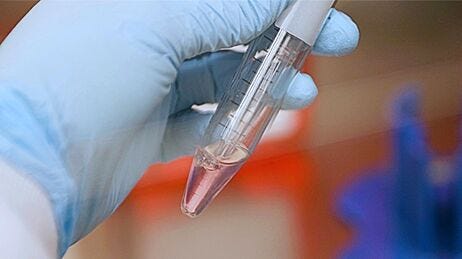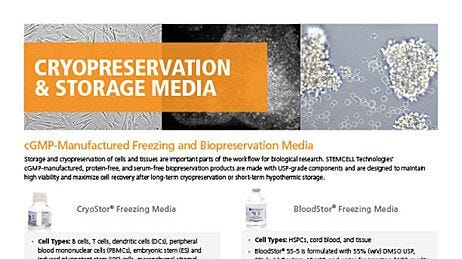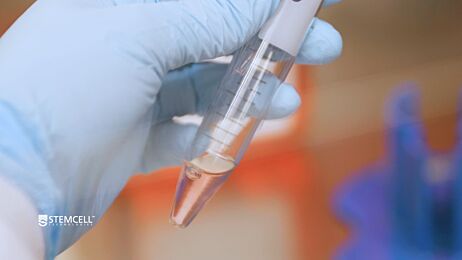Cryopreservation and Thawing of Pluripotent Stem Cells: Technical Tips and Media Recommendations
Technical tip from our dedicated team of Product and Scientific Support specialists
The following technical tip is for the freezing and thawing of human embryonic stem (ES) cells or induced pluripotent stem (iPS) cells cultured in mTeSR™1, mTeSR™ Plus, eTeSR™, or TeSR™-E8™ in 6-well plates using either mFreSR™ (for cells cultured in mTeSR™1/mTeSR™ Plus only) or CryoStor® CS10 for cell aggregates, and FreSR™-S for single cells. For complete instructions, refer to the Technical Manual: Maintenance of Human Pluripotent Stem Cells in mTeSR™1 (Document #10000005505), mTeSR™ Plus (Document #10000005507), eTeSR™ (Document #10000019963), or TeSR™-E8™ (Document #10000005516), or contact us to request a copy.
Pluripotent stem cell (PSC) cultures should be harvested and cryopreserved at the time they would normally be ready for passaging. Each vial should contain the cell aggregates from one well of a 6-well plate. If using other cultureware, adjust media volumes accordingly.
Should I Freeze Aggregates or Single Cells?
- Faster recovery as no need to transition from single cells to clumps
- Ease of use (no need for ROCK inhibitor)
- Consistency between vials
- More accurate cell count
- Different number of cells (aggregates) per vial
- Time to first passage less predictable
- Requires ROCK inhibitor for first 24 hours
Recommendations for Freezing and Thawing PSCs in Aggregates
- CryoStor® CS10 or mFreSR™ (for PSCs cultured in mTeSR™1 /mTeSR™ Plus only) are the recommended pluripotent stem cell cryopreservation media
- You may optimize your cryopreservation protocol to generate larger clumps (> 150 µm) by:
- Using 2 mL serological pipettes
- Reducing incubation time to ~1 - 2 minutes and minimizing scraping if using Gentle Cell Dissociation Reagent (GCDR)
- Reducing incubation time to ~1 - 2 minutes if using ReLeSR™
- When thawing, lightly triturate larger clumps prior to seeding to generate 50 µm aggregates
- If only a few undifferentiated colonies are observed after thawing, it may be necessary to select only these colonies for passaging and replate them in the same size well (i.e. without splitting) on a newly coated plate
Recommendations for Freezing and Thawing PSCs as single cells
General Tips for Freezing and Thawing PSCs
Cryopreservation
- Chill cryopreservation medium before starting dissociation
- Cryopreserve the contents of one well of a 6-well plate per cryovial at the time of passage (can vary depending on the density of the cultures)
- Freeze 1 x 106 cells/cryovial
- Passage hPSCs as aggregates, since serial single-cell passaging can increase the risk of karyotype abnormalities1,2. If single-cell passaging is preferred or required for downstream applications, use eTeSR™ to enhance the genetic stability of your cultures.
Thawing
- Quickly thaw cells in a 37°C water bath or the ThawSTAR® CFT2 Automated Thawing System for ensured sample sterility and consistent thawing performance. Wipe down the outside of the bottles/vials with 70% ethanol or isopropanol before opening
- When only a small ice pellet remains, transfer the cells to an empty conical tube using a 2 mL serological pipette. Add the PSC maintenance media dropwise to cells to avoid osmotic shock and improve recovery
- Thaw cells into the same culture system from which they were cryopreserved for one passage prior to transition into mTeSR™1/mTeSR™ Plus or TeSR™-E8™
- Seed the equivalent of one cryovial of cells into 1 - 2 wells of a coated 6-well plate (depending on the number of aggregates or single cells cryopreserved)
- The first passage post-thaw may be required sooner than expected. The cultures tend to be very confluent and may merge into each other. After one passage with adjustment to a proper seeding density, the morphology should recover.
When to Use ROCK Inhibitor (Y-27632)
For Single Cells
- Add to single-cell cryopreserved cultures for 24 hours post-thaw
For Aggregates
- May be added to PSC cultures frozen as aggregates post-thaw for 24 hours. We do not recommend this method as this may increase the seeding density, forcing passage sooner than optimal, or may result in overgrowth or other issues
- Will help attachment of human ES/iPS aggregates, but it is not necessary
STEMCELL Products for PSC Culture, Cryopreservation, and Thawing
Need help choosing the right media and reagents for your experiments? We can help. Contact us by phone or email, or use the LiveChat function on this page to discuss your specific needs and applications.
Related Resources
- Draper JS et al. (2004) Recurrent gain of chromosomes 17q and 12 in cultured human embryonic stem cells. Nat Biotechnol 22(1): 53–4.
- Buzzard JJ et al. (2004) Karyotype of human ES cells during extended culture. Nat Biotechnol 22(4): 381–2.
Request Pricing
Thank you for your interest in this product. Please provide us with your contact information and your local representative will contact you with a customized quote. Where appropriate, they can also assist you with a(n):
Estimated delivery time for your area
Product sample or exclusive offer
In-lab demonstration






